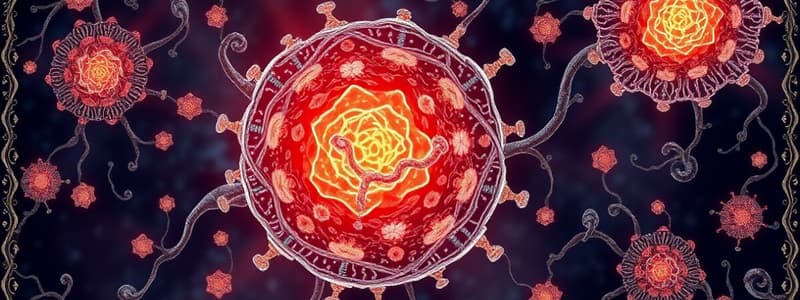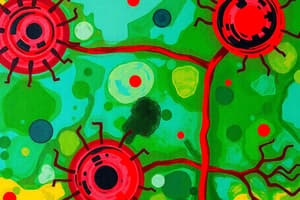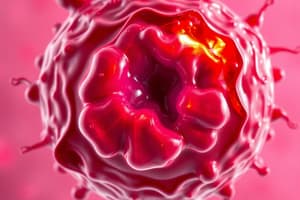Podcast
Questions and Answers
What is the most common cause of clinically significant cell damage?
What is the most common cause of clinically significant cell damage?
- Toxic substances
- Hypoxia (correct)
- Infection
- Physical injury
What initiates ischemia and leads to hypoxia?
What initiates ischemia and leads to hypoxia?
- Arterial occlusion (correct)
- Anemia
- Hyperoxia
- Venous obstruction
Which organelle is affected first in a hypoxic cell?
Which organelle is affected first in a hypoxic cell?
- Nucleus
- Ribosome
- Golgi apparatus
- Mitochondria (correct)
What occurs as a result of hypoxia and affects cellular morphology?
What occurs as a result of hypoxia and affects cellular morphology?
What is primarily impaired in a hypoxic cell due to ATP depletion?
What is primarily impaired in a hypoxic cell due to ATP depletion?
Which process increases due to the impaired Na-K pump during hypoxia?
Which process increases due to the impaired Na-K pump during hypoxia?
What is a significant finding on light microscopic examination of a hypoxic cell?
What is a significant finding on light microscopic examination of a hypoxic cell?
What substance increases in concentration during anaerobic glycolysis as a result of hypoxia?
What substance increases in concentration during anaerobic glycolysis as a result of hypoxia?
Flashcards
What is the most common cause of cell damage?
What is the most common cause of cell damage?
Hypoxia, a lack of oxygen, is the most common cause of clinically significant cell damage.
What is ischemia?
What is ischemia?
Ischemia is a condition where blood flow to a tissue is reduced, leading to hypoxia.
Which organelle is affected first in hypoxia?
Which organelle is affected first in hypoxia?
The mitochondria, the powerhouse of the cell, is the first organelle affected by hypoxia.
What is the initial morphological change in hypoxia?
What is the initial morphological change in hypoxia?
Signup and view all the flashcards
How does hypoxia affect the Na-K pump?
How does hypoxia affect the Na-K pump?
Signup and view all the flashcards
What is the role of the Ca pump in cell damage?
What is the role of the Ca pump in cell damage?
Signup and view all the flashcards
How does calcium buildup damage the cell?
How does calcium buildup damage the cell?
Signup and view all the flashcards
What is apoptosis?
What is apoptosis?
Signup and view all the flashcards
Study Notes
1-Cell Injury: Mechanisms of Damage
- Ischemia is a common cause of clinically significant cell damage, primarily due to hypoxia (lack of oxygen).
- Arterial occlusion is the most frequent cause of ischemia.
- Hypoxia initially affects mitochondria.
- The Na-K pump malfunctions, leading to increased sodium, water, and calcium entry into cells and potassium loss.
- Cellular swelling is the initial morphological change observed in hypoxic cells.
- The first organelle affected during hypoxia is the mitochondria.
- Aerobic respiration is first affected in hypoxic cells.
- Anaerobic glycolysis increases to produce energy, but this increases lactate levels and lowers the pH.
- Protein synthesis decreases and intracellular lipid accumulates.
- The Na-K pump dysfunction, coupled with increased intracellular sodium, leads to cellular swelling and efflux of potassium.
- Microvilli (small finger-like projections) disappear.
Acute Cellular Swelling
- Cellular swelling is the first detectable morphological change in cell injury due to hypoxia.
- The affected cell's mitochondria are the first organelle to be impacted.
- Aerobic respiration is the first system disrupted in hypoxic cells.
Cellular Swelling and Lubrication
- Cellular swelling and lubrication are the first morphological signs during light microscopic examination.
Further Mechanisms of Cell Injury
- The Na-K pump's failure leads to increased sodium, water, and calcium influx into the cell and potassium efflux.
- Cell and endoplasmic reticulum swell.
- Anaerobic glycolysis increases to provide energy.
- Glycogen decreases, while lactate and lactic acid increase (lowering internal pH).
- Chromatin aggregates and become more coarse.
- Protein synthesis slows.
- Intracellular lipid begins to accumulate.
Calcium Imbalance and Apoptosis
- Calcium pump impairment (due to ATP depletion) results in calcium increase inside the cell.
- Elevated intracellular calcium activates enzymes (ATPases, phospholipases, proteases, endonucleases), leading to membrane damage, cytoskeletal damage, and nuclear chromatin damage.
- Calcium disrupts mitochondrial function, increasing cytochrome C release.
- Cytochrome C triggers caspase activation, initiating apoptosis (programmed cell death).
Substances Affected in Hypoxic Cells
- Decreased Substances: Potassium, protein, glycogen, and ATP.
- Increased Substances: ADP, inorganic phosphates, sodium, chloride, calcium, purine nucleosides, lactic acid, and water.
Studying That Suits You
Use AI to generate personalized quizzes and flashcards to suit your learning preferences.




